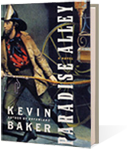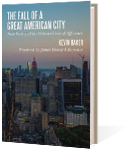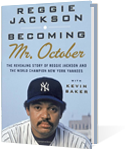Before we build better ballot technology, we should ask what we want that technology to do.
The first patent Thomas Edison was ever granted, at the age of 22, was for a ballot machine designed to instantly record votes made by members of Congress. It was a flop. The machine worked very well, and Edison had found a financial backer willing to invest $100 in it. Yet, when he demonstrated his new device in Washington, he was told that it would only destroy the time-honored congressional device of filibustering, for example, stalling for time. “Young man, that is just what we do not want,” a committee chairman told the future Wizard of Menlo Park. “Your invention would destroy the only hope that the minority would have of influencing legislation.”
Crushed—and nearly flat broke—the young Edison left the nation’s capital determined from then on to invent only things that would be in “commercial demand.” The second patent he would apply for proved to be just that—a telegraphic device that was a predecessor to the modern stock ticker. A few more patents and refinements to his invention netted him some $30,000 by the following year, a tidy sum for 1870. Edison would use it to set up the first of his wondrous laboratories in New Jersey. He never looked back.
Lurking in this Horatio Alger story is a lesson about the opportunities and the limitations of information technology. The men who ran politics at the turn of the last century had no interest in methods of voting, inside or outside the legislative chambers, that could not be maneuvered as they saw fit. Investors, on the other hand, were very interested in getting fast, accurate financial information, and were often willing to sacrifice some control to get it. In both cases, the technology was shaped by a desired outcome. As Florida has amply demonstrated to us this election season, technology can also lead to a most undesirable outcome. Thus, much of the public discussion so far has focused on machines. Was the ballot designed properly? Are the punch card readers accurate? And what about those mysterious chads?
The subtext of this conversation is that better technology—perhaps computerized ballots or even Web-based voting—will somehow lead to a more perfect union.
Well, maybe. I know that the voting booths I use in New York City usually work fine. These are old-fashioned voting machines; incredibly dense, 700-pound devices that have evolved only slightly from safe-builder Jacob Meyer’s original 1898 design. Pull a lever and you half-expect them to start dispensing packs of cigarettes, or maybe ball bearings. And yet they have none of the problems the Florida machines did. Trying to vote for two people for president? The machine blocks you. Make a mistake? Go back and change it—your vote is not counted until you swing a great, red lever at the bottom that can no more be overlooked than the fireman’s brake on a locomotive. What’s more, the incredible bulk of these machines makes them extremely difficult to abscond with or to hurl into the East River—time-honored, Tammany Hall recount procedures—without causing a small tidal wave in Queens.
Still, these machines have not been manufactured in some 20 years now, and are starting to get a little crotchety. Many in the chattering class are itching to replace them—not to mention Florida’s wretched ballot—with something new. Already, some of the more vapid television commentators are making noises about how we have to start voting “on the Internet” (no doubt because their kids told them it’s neato) even though most of the people who actually seem to know something about the intricacies of voting on the Net think it will be decades, if ever, before any such system is generally accepted as foolproof.
All this only underscores the limitations of any technology, be it old, new or idiotic. The first question that has to be asked in successfully applying technology is: What do you want from it?
American investors very much wanted fast, accurate financial information, and for good reason. A veritable mania for information had swept the precincts of Wall Street beginning with the Civil War. The gold market swung wildly with each Union victory or defeat. And the years just after the war would bring some of the most outrageous swindles and hoaxes in the history of Wall Street, including the attempt by Jay Gould and Jim Fisk to corner the gold market by bribing President Grant’s brother-in-law. Wall Street was a ruthless place, but this sort of thing was a little much even for the resident sharks.
The stock ticker was the start of a long line of information improvements. The wheelers and dealers on the Street were less enthusiastic about some of the later changes made over the course of the next few decades, including rules about disclosure and insider trading. Yet the right information—the right technology—convinced most Americans that Wall Street was more than a bunch of bucket shops where they were likely to be fleeced. The instant, and constant, dispersal of information made it possible for people to check the market from all over the world, in real time. Full disclosure laws gave them some faith in what they were doing, and most traders were finally convinced that the sacrifice of any financial killings they might make, thanks to exclusive inside information, would be more than offset by the creation of a market beyond their wildest dreams. This leaves the question, what do we want from our politics? What do we want technology to do for us here?
Edison’s political bosses, so long ago, asked themselves, Do we really want fast, completely accurate, incorruptible vote counts? Their answer was a resounding No!—but since then, of course, the control of the old bosses has lapsed, and it has fallen to the rest of us to decide what we want.
These choices are about much more than what kind of machines we put in the voting booth down at the local library. Do we want to retain our Electoral College system, for example, under which the importance of absolute accuracy is magnified, imbroglios like Florida’s are made more likely and a minority can win the vote? Or do we want a straight popular vote and a runoff—even though regional preferences will become less important and future presidential candidates may ignore some small states altogether? The answer to that will inform whether we choose to adopt some kind of standard, national voting machine to replace all those wacky Florida styluses and punch cards—or continue to prefer having our friends and neighbors design and count our ballots.
In short, what’s going on in Florida is first and foremost a failure to think about the technology—and only second a failure of the technology itself. We will only compound this error if we rush, willy-nilly, into some brave new world of Internet voting, bigger styluses or talking ballots (“If you want George Bush, punch me here!”), without considering what kind of democracy we really want.
Edison understood well the power of deliberation. Working on another project, soon after his invention of the prototypical stock ticker, he found himself pushing himself and his men to the limits of their endurance, working up to 90 hours a week, right through Christmas.
When a kibitzing investor worried that things were still not going fast enough, however, Edison only commented that his experiments and researches were a legitimate business, and that like “all legitimate businesses they are slow but sure, and the slower the more sure.”
What made Edison great—what made him more beloved than all the other, superb tinkerers who have bestrode our republic—was his insistence on inventing the practical. Indeed, pragmatism in the pursuit of every ideal might have been his watchword. That takes time, but it would serve as well for our democracy.
© Copyright The Industry Standard









